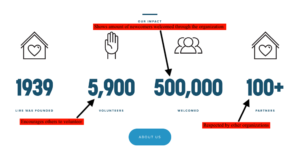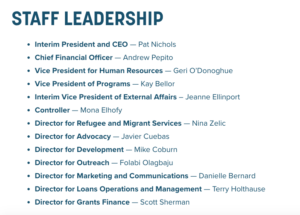The Lutheran Immigration and Refugee Service (“LIRS”) is a nonprofit organization that helps refugees, migrants, and those seeking asylum become integrated within United States communities by using a rhetorical situation. Writer Designer describes a rhetorical situation as a set of circumstances in which an author creates a text (Writer/Designer 21). In order to create a useful text, one must focus on the audience, purpose, context, and genre and apply it correctly (Writer/Designer 21). LIRS uses a website in order to effectively persuade their audience to direct change regarding immigration in the United States through thoughtful incorporation of audience, purpose, context, author, and genre into their website (Writer/Designer 21).
Audience
Rhetorical analysis of LIRS’s text demonstrates that the intended primary audience is for refugees, children, migrants, and those seeking asylum in United States communities. A secondary audience for LIRS may be those who are becoming familiar with the political climate regarding immigration and are inquiring information. Additionally, a secondary audience may also be those who are interested in volunteering for an immigration detention center, those willing to contact their local congressperson to impact legislative efforts and policy changes, and others who desire to donate to the organization. The values that the primary and secondary audiences hold is most likely in accordance with the same opinions of LIRS because the audiences may be trying to advance LIRS’s position in taking action and helping refugees and migrants.

Purpose
The purpose of LIRS’s text is to explain their efforts in helping refugees, migrants, and those seeking asylum because the text lists how LIRS has welcomed more than 500,000 newcomers. LIRS states that they help the newcomers as they are in the process of coming into the United States and will continue to help them once they arrive.

A secondary intention of the website is to obtain new volunteers and donations to contribute to the organization. The menu bar button states “Take Action,” which gives the audience an option of advocating, hosting an event, volunteering, and giving to the organization. In fact, the “Donate” button in the screenshot above is surrounded by bright orange, unlike the other menu buttons. This is intended to stand out for users, which makes it more likely for them to donate to the organization. The color of the Donate button represents a visual mode because of its ability for the audience to likely notice the button, and it also represents spatial mode because the author carefully places the button on the right-hand corner so the audience can easily donate without any difficulty and have a good user experience.  Additionally, another secondary intention may be those seeking information about the political controversy regarding immigration by referring to the “Blog” button. The text provides published blog posts that discuss different categories regarding advocacy, community engagement, immigration detention, etc. The audience may choose which topic they wish to read about after clicking on the drop-down bar. The audience may even choose to leave their own comment on the blog posts themselves to provide their own feedback. This drop-down bar is easily accessible to navigate, and it helps LIRS communicate their call for action.
Additionally, another secondary intention may be those seeking information about the political controversy regarding immigration by referring to the “Blog” button. The text provides published blog posts that discuss different categories regarding advocacy, community engagement, immigration detention, etc. The audience may choose which topic they wish to read about after clicking on the drop-down bar. The audience may even choose to leave their own comment on the blog posts themselves to provide their own feedback. This drop-down bar is easily accessible to navigate, and it helps LIRS communicate their call for action.
Context
LIRS uses the medium of their text as a website, which can be found using the text’s URL (https://www.lirs.org/). The author chose this medium because almost every organization creates a website in order to attract more recognition and gain success as a business. If LIRS did not have a website, they would not be able to collect online donations and publish as much information for users. The social and cultural connotations within the text are that it allows users to have easy access to the LIRS organization, by using blog posts, bold and colorful font, and pictures.

Readers can interact with the text through computer, phone, and tablet. The view of the text on a phone is easily accessible and looks just as good as it does on a computer. The phone view provides all of the same functions as a computer view. The organization and alignment of the phone view are thoughtfully arranged, and the audience should have little difficulty in navigating around the website. Therefore, LIRS allows its audience to easily access their information and resources, which help persuade their organization’s message to its users.
Author
The author of the text is Lutheran Immigration and Refugee Service, which was founded in 1939 by Lutheran churches in the United States that initially served to help newcomers in the United States during World War II. While the actual author is unknown, it most likely is either a group of people within the organization or a contractor for the organization who designed the website to help establish their call to action. On the face of the website, the organization seems credible and trustworthy due to its large amount of information and well-designed website. Below, the author identifies leadership positions within the company in bright, bold font in order to emphasize credibility among leaders, which will ultimately help persuade the audience to believe that LIRS has a good reputation.
 The author comes across as knowledgeable in the steps that LIRS takes in helping migrants and refugees, and the text works to supports this reputation because of the vast information provided such as numbers and blog posts. To better understand LIRS, Wikipedia provides some detail by stating that LIRS has 103 employees, $50.4 million in revenue for 2013, and it is a faith-based organization that is rooted in three national Lutheran denominations (“Lutheran Immigration and Refugee Service”). By being in business since 1939 and acquiring such a large revenue for 2013, this helps users better understand LIRS’s good reputation.
The author comes across as knowledgeable in the steps that LIRS takes in helping migrants and refugees, and the text works to supports this reputation because of the vast information provided such as numbers and blog posts. To better understand LIRS, Wikipedia provides some detail by stating that LIRS has 103 employees, $50.4 million in revenue for 2013, and it is a faith-based organization that is rooted in three national Lutheran denominations (“Lutheran Immigration and Refugee Service”). By being in business since 1939 and acquiring such a large revenue for 2013, this helps users better understand LIRS’s good reputation.
Genre
The genre of the text is an informational website in which users can obtain resources, get involved, and donate to the organization. The ways in which the text is similar to texts for other organizations, like Esperanza Center and Maryland Immigration Rights Coalition, is that each has buttons provided for users to access resources on how to get involved by donating and volunteering. Additionally, each website provides contact information for their organizations and search buttons to help users find what they are looking for within their websites. Each provides news archives that discuss current events regarding immigration. LIRS follows similar genre conventions that other nonprofit organizations follow in order to satisfy audience expectations.
Rhetorical Analysis of the audience, purpose, context, author, and genre of LIRS’s text demonstrates it to be an effective website that provides useful information regarding its work for immigrants and refugees, while also reaching out to those who may be interested in participating in LIRS’s call for action. The easily accessible website has been thoughtfully constructed for the audience to understand LIR’s message. The website could be better by providing real-life stories of migrants and refugees who were successfully integrated into the United States with the help of LIRS directly on the landing page.
Works Cited
Arola, Kristin L., et al. Writer/Designer: A Guide to Making Multimodal Projects. Bedford/St. Martin’s, 2014.
“Esperanza Center.” Catholic Charities of Baltimore, www.catholiccharities-md.org/services/esperanza-center/.
“Lutheran Immigration and Refugee Service.” LIRS, 6 Feb. 2019, www.lirs.org/.
Maryland Immigrant Rights Coalition, marylandimmigrantrightscoalition.org/.
Wikipedia contributors. “Lutheran Immigration and Refugee Service.” Wikipedia, The Free Encyclopedia. Wikipedia, The Free Encyclopedia, 7 Feb. 2019. Web. 11 Feb. 2019.